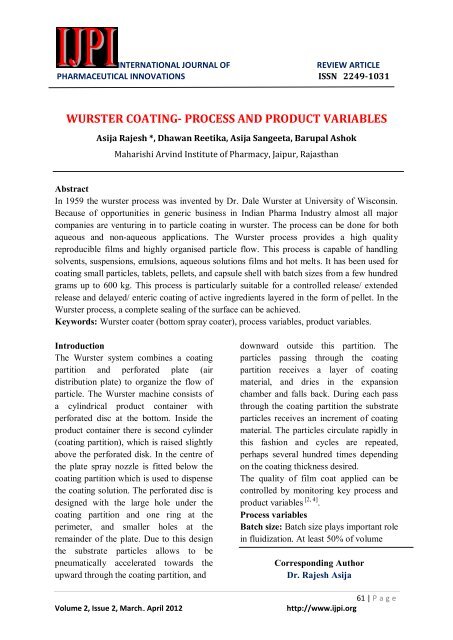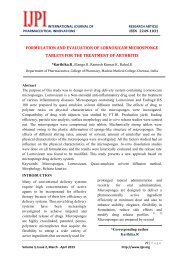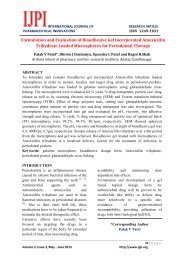WURSTER COATING- PROCESS AND PRODUCT VARIABLES - IJPI
WURSTER COATING- PROCESS AND PRODUCT VARIABLES - IJPI
WURSTER COATING- PROCESS AND PRODUCT VARIABLES - IJPI
You also want an ePaper? Increase the reach of your titles
YUMPU automatically turns print PDFs into web optimized ePapers that Google loves.
INTERNATIONAL JOURNAL OFREVIEW ARTICLEPHARMACEUTICAL INNOVATIONS ISSN 2249-1031external to coating partition must beoccupied by the particles to be coated. Thismakes it possible to have sufficientquantity of particles inside the partition toaccumulate the maximum coating solutiondroplets and to avoid premature drying, ordepositing on the walls of the partition. Tocalculate load of particles to be introducedfollowing formula can be used-M= (r 1 2 -r 2 2 ) πLρ pWhere r 1 and r 2 are chamber radius andpartition radius, L is the length of thepartition; ρ p is bulk density of particles [7] .Air Distribution Plate: Suitable baseplate has to select to get consistentfluidization at minimum attrition. Thefluidization volume affects particlevelocity; the smaller particle requireslesser air volume to attain certain heightthan the bigger particles. The differentialpressure and air velocity at the airdistribution plate must be almost same.Therefore when we deal with the smallerparticle we have to use plate with lesseropening area to create the resistance at theAir Distribution Plate to have betterdistribution of the air [6, 1] .Fluidization Air Flow: The inlet airvolume is not to dry the product it has tobe used to achieve desired fluidizationpattern. The drying of the product can beachieved by adjusting the temperature. Fornon-aqueous coating a bubbling type offluidisation in down bed is suggested tominimize the generation of static chargeand particle friction, whereas for aqueouscoating more rigorous fluidization isneeded to have more drying efficiency. Atlow airflow rates the air passes through thebed without disturbing the solid particles,as air flow is increase some of particles getVolume 2, Issue 2, March− April 2012start to move upward. When the air flow isincrease up to certain value particles startmoving upward and fell through innercylinder like a fountain. During this thepressure drop and remain constant, andparticle moves in regular way [1, 6, 7] .Fluidization Air Humidity: Inlet airhumidity is the most critical factor. Itshould be considered because before itenters the HEPA filters, get heated andpass through the equipment air is drawnfrom the external environment. Thehumidity of air may vary from season toseason or day to day. The changes in dewpoint of air changes the evaporatingefficiency of that air.Lower humidity inthe inlet air will enhance the dryingcapacity of air even at low temperature butit will cause excessive static charge in theproduct. To eliminate static charge andprocess variability, the required specificand absolute level must be set at the initialstage of development itself. Too highabsolute humidity will result in adepression in air temperature below dewpoint, which will cause the condensationof water either on to machine or productsubstrate surface. It is not recommended tokeep high moisture for a highly watersoluble substrate at intial stage. Thehumidity can be increased after the initialcoating because the static charge developsonly once the pellets are coated withpolymers [2, 5,11] .Fluidization Air Temperature: It willdepend on the spray rate, type of solvent,tackiness of solution and have directimpact on product humidity and producttemperature. For aqueous solvent hightemperature is needed to avoidagglomeration of particles while for non-62 | P a g ehttp://www.ijpi.org
INTERNATIONAL JOURNAL OFREVIEW ARTICLEPHARMACEUTICAL INNOVATIONS ISSN 2249-1031selection of nozzle, smaller the nozzleinsert, more consistent will be spray.However smaller nozzle insert may causenozzle choking. To avoid agglomeration inwurster coater the coating fluid is to beatomized more finely than in pan coaterfor tablets. It is necessary that the nozzleused in capable of atomising the coatingfluid even if the coating fluid delivery rateis increased. Large droplets of coatingfluid generated by low performance nozzledoes not distribute evenly over the materialto be coated and do not dry quickly assmaller droplets. Very small droplets maydry quickly. Some droplets may contacttablets or beads surface but may dry beforegetting spread, it will result in to theirregular surface on core material. Tomaintain uniform atomisation when sprayrate exceeds the capacity of nozzle largedroplets of coating fluid appears alongwith small droplets, large droplets resultsin to the formation of agglomerates. Toavoid agglomeration multiple unit nozzlesshould be used. [1,8, 10,11] .Atomisation Air: If the atomisationpressure is high then the mist size will belower, then the chances of agglomerationwill also low. Excess pressure will lead toa particle shooting to the filter bag. Theatomisation pressure varies from 2 bar to 4bar. This will depend upon the kind ofbinder used its evaporation rate and itsviscosity. If in the finished granulationlumps of binder is present, then that wouldmean the air pressure has been lower thanrequired. The atomisation air must beadjusted to keep enough to avoidagglomeration. During the optimisation ofspray rate to achieve fastest possibleprocess, one has to keep droplet veryVolume 2, Issue 2, March− April 2012small. Higher the pressure smaller will bedroplet [2, 5, 7] .Product variablesCore particle: In some cases the coreparticles are used, it can be drug core itselflike spherodised and extruded product orpellets of inert material used to load drug.Controlled release of drug is mainlydependent upon the thickness of the filmon the pellets. If the specifications set forthe core is not rigid enough and if theaverage particle size of core varies, evenby 50 micron, this will lead toconsiderable change in the film thicknesswith same % coating.Particle surface: If the particle surfacewill rough the total coating area availablefor coating will change. The pellets withrough surface will have more surface areathen a pellet with smooth surface. To coveredges and crevices of rough pellets one hasto make film thicker but the total quantityapplied typically may exceeds theminimum required for acceptableperformance. And large pores may neverbe covered, resulting in an imperfection inthe film. Due to attrition during theprocess it is not easy to preserve the drugpellets as smooth as possible. In oneinstance, the product temperature in drugloading stage changed .when the producttemperature reduced from 60 to 35°C, onthe whole SR coating required to getdesired release was diminished from 21%to 12% even though all parameters in SRcoating kept same. This is mainly due tosmooth surface of the drug pellets whenprocessed at low temperature due toreduced spray drying and higher moisture.When the drug loading was done at highertemperature, the surface of drug loaded64 | P a g ehttp://www.ijpi.org
INTERNATIONAL JOURNAL OFREVIEW ARTICLEPHARMACEUTICAL INNOVATIONS ISSN 2249-1031pellets was rough and porous due to spraydrying effect. To cover these pores one hasto apply more coating.Particle size: As the particle sizedecreases the amount of coating materialrequire for desire thickness becomes veryhigh. The quantity of liquid also increasesas a result of decrease in particle sizebecause coating substance must be appliedusing some medium which is solidconcentrations in liquid in range of 10 to30%. Further complication is that as theparticle size decreases agglomerationbecomes more dependent on theformulation of the coating liquid andnozzle which is unavoidable. So itsuggested to use large particle size thatmay reasonably produce the desired results[6] .Product temperature: Specification ofproduct temperature will depend upon theglass transition temperature of polymer. Toget maximum efficiency it is we have tokeep product temperature as low aspossible. Lower the product temperaturelesser will be the static charge generationbut for some polymer like HPMC we haveto maintain high temperature to minimisethe agglomeration by drying the filmeffectively [1, 7] .Solution Viscosity and SolutionConcentration: We have to optimise theseparameters to have better control on theprocess. We have to reduce the spray rateif the solution is viscous and tacky. It isgenerally known that, higher solid contentwill reduce the process time. But it isopposite in case of polymers like HPMCand ethyl cellulose when they are insolution form. As we increase the solidcontent beyond certain limit for theseVolume 2, Issue 2, March− April 2012polymers, the spray rate will reduceradically, which results in higher processtime [2, 6] .Bulk Density of Finished Product: Onceit was thought it is uncontrollable propertybut research has shown that byconcentrating on two variables it can bereduced or altered. These factors are the inprocess moisture and the fluidizing airvolume. The lowest possible finishedproduct bulk density can be achieved bykeeping the bed moisture at or below themaximum finished product moistureduring spraying. In this way drying stage(which can cause product attrition andincreased bulk density) is not needed afterspraying. Volume of fluidizing air can beaffected by several factors. As the outer airfilter or the product bowl screen becomesoccluded by binder, by coating material, orby fine powders resistance to air flowincreases. Without a warning indicator thevolume of air can drop enough to cause thebed moisture to increase thereforeincreasing the bulk density of finishedproduct [1, 6] .References1. Jones David M. Factors to Consider inFluid Bed Processing. PharmaceuticalTechnology.April 1985.2. Dr. Mehta Atul M. Scale upConsiderations in the Fluid BedProcess for Controlled ReleaseProduct. Pharmaceutical Technology.Feb. 1988.3. Lachman Leon, Lieberman Herbert A.Kanig Joseph L.The Theory andPractice of Industrial Pharmacy. 3rd ed.Bombay: Varghese publishinghouse.1987:419 - 420.65 | P a g ehttp://www.ijpi.org
INTERNATIONAL JOURNAL OFREVIEW ARTICLEPHARMACEUTICAL INNOVATIONS ISSN 2249-10314. Swarbrick J, BoylanJ.C. Encyclopaedia of PharmaceuticalTechnology. vol1. New York: MarcelDekker INC. 1992: 196-200.5. Swarbrick J, BoylanJ.C. Encyclopaedia of PharmaceuticalTechnology.vol 6. New York: MarcelDekker INC.1992: 171-176.6. Shetty Vasant. Wurster Coating - Scaleup and Scale out. Pharma times.November 2010;42 (11):33-377. Mafadi EL S, Hayert M, Poncelet D.Fluidization control in the wurstercoating process. Chem.Ind.2003;57(12): 641-644.8. http://2.imimg.com/data2/LO/HF/MY-/fbp1.pdf.9. Chauhan Jitender, YadavPoonam.Study of scale up parametersof fluidized bed coating. DerPharmacia Sinica 2011.Availablefrom:URL:http://pelagiaresearchlibrary.com/der-pharmacia-sinica/vol2-iss1/DPS-2011-2-1-228-238.pdf.10. Harlan S Hall. Scaling of fluid bedcoating. Pharmatech.2004; 96-102.11. McGinity James W., Mehta Ketan A.,Frisbee Steven E. Processing factorsthat influence the in vitro in vivoperformance of film coated drugdelivery system. Drug Developmentand Delivery.2002; 2(1).Volume 2, Issue 2, March− April 201266 | P a g ehttp://www.ijpi.org
















